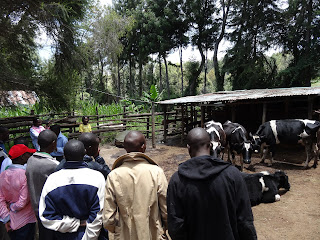By Sara:
Like I said when I shared about bee keeping, I surveyed the students last year about skills they wanted to learn. One skill which many students were interested in was how to make yogurt. Conveniently, this is something I know how to do well and have a lot of experience in. I even discovered a new way of making yogurt using a tool which everyone here in Kenya has: a thermos (also, I quickly realized that Kenyans call it a thermos after people here didn't know what I was talking about when I initially called it a flask, which is what Ugandans call it).
First, I taught the people from the farm. They were interested in yogurt making too, especially since they raise dairy cows and have plenty of milk.
It's actually a very simple process. First, you heat the milk to almost boiling, when it starts foaming (this is about 85ºC - one student asked a very good question about whether the milk was safe, since he had heard that you need to boil milk to kill pathogens in it. Boiling is the easiest way to know you have pasteurized milk, but in reality, you only need to heat it to 165ºF for 30 seconds to pasteurize it. And 85ºC is close to 185ºF, so you're good). Then, let the milk cool to 45ºC, which is cool enough to dip (a clean) finger into and not feel burned. That's what is going on in the picture below:
Then, you add a few tablespoons of yogurt to get the bacteria working on creating more yogurt. Pour the mixture into a thermos, close it tightly, and leave it for 8-24 hours.
Now in all the times I have made yogurt, I have never, not even once, had it not work out. Unfortunately, this one time I was teaching the students, it did not get very thick. It so happened that when they tested the temperature of the cooled milk, it was still really hot (apparently the student who tested it has very high pain tolerance), so the bacteria didn't do their job very well. The good news is that the yogurt at the farm was very successful. And even though the one for the students didn't turn out the way I would have liked it, they were pretty thrilled (even though they don't look it in the picture below...)
In addition to the yogurt lesson, the students were interested in learning more about raising dairy cows, so I asked Evans, who is in charge of the college cows, to share his knowledge with them. The students had a fun time going over to the dairy, looking at the cows, and asking him all their burning questions.
We even went to take a look at the different kinds of crops they could grow to feed cows, including some which grow wild here.









I've been using the same method to make yogurt. A thermos is really easy to find in China (traditionally used for hot water), and it works so well. I usually drain it for a bit to get more of a Greek yogurt type consistency.
ReplyDeleteWowww
ReplyDelete